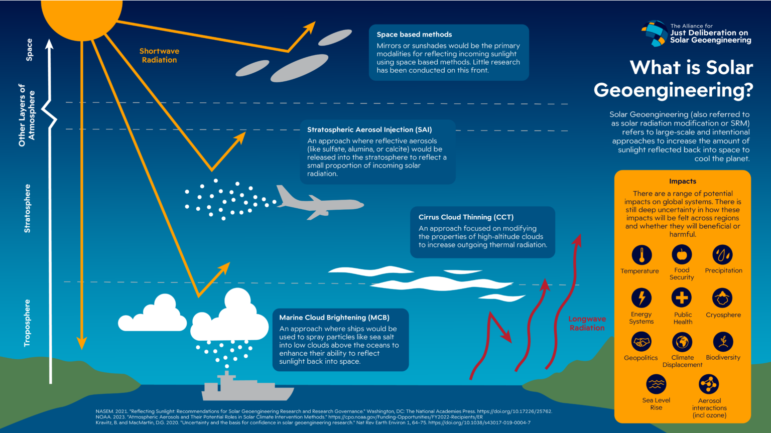With global temperatures spiking ever higher,
CCAN supports careful research into geoengineering
Despite extensive policy successes at the state, federal, and international levels in recent decades, the problem of climate change continues to worsen. The transition to a clean energy economy is well underway worldwide, to be sure, and no U.S. President or Congress can stop it. But past and ongoing delays created by the fossil fuel industry mean that full decarbonization is still decades away.
This delay has allowed climate change to approach runaway status. The vital Gulf Stream is slowing down in the Atlantic while heat waves, hurricanes, and lethal flooding are becoming the norm in the US and worldwide.
WATCH THIS VIDEO to hear our Executive Director, Mike Tidwell, share CCAN’s viewpoint.
Which is why America’s most famous climate scientist Dr. James Hansen and others from across the world — including the Global South — are now calling for rapid research into the best potential ways to temporarily reflect 1-2% of incoming sunlight away from Earth for the next several decades — while we complete the clean-energy transition. Also known as geoengineering or “solar reflective methods,” this idea of studying ways to artificially cool the Earth has in the past been quite controversial but has now drawn support from entities as diverse as The Washington Post and the National Academies of Sciences. The Biden Administration in 2023 produced guidelines for conducting such research and testing.
After much internal deliberation and conversations with allies and relevant scientists, the Chesapeake Climate Action Network has decided to support careful and transparent research in this emerging realm of science. Our statement of principles, written with input from all our staff members, carefully guides our advocacy.
Watch Now: Geoengineering Research Townhall at NYC Climate Week Highlights
We hosted a rousing townhall and community conversation at NYC Climate Week in September 2025 called “SRM & Climate Justice: Navigating Uncertainty, Urgency, and Hope.”
Our town hall at NYC Climate Week included two panel discussions and a Q&A. The first panel was on climate justice and how solar geoengineering could hypothetically help the people most hurt by climate change most directly. The second panel was focused on bringing perspectives from the Global South into the conversation. Then we had a Q&A in the format of a climate community town hall, where anyone in the audience could weigh in.
Watch the full townhall at this link, or a five-minute highlight video below!
Statement of Principles on the Issue of Geoengineering Research Advocacy
Whereas planetary warming is already at or near 1.5 degrees Celsius above pre-industrial levels and scientists warn any warming beyond this amount could bring dangerous and irreversible harm to the planet;
Whereas the stunning impacts of the warming so far already include up to 400,000 deaths per year worldwide, growing food insecurity in some of the world’s poorest nations, and the quickening collapse of the Thwaites Glacier in Antarctica that could by itself trigger to as much as ten feet of sea level rise;
Whereas since June 2023, the rate of warming has begun to increase so quickly that our best predictive climate models struggle to explain it, likely pointing to thresholds that have been crossed that are triggering potentially disastrous feedback loops;
Whereas the clean-energy revolution is well underway but is still decades from full implementation, and efforts to capture and sequester carbon directly from the atmosphere are in their infancy;
Whereas Dr. James Hansen, America’s most prominent climate scientist — and scores of other leading scientists — now calls for “rigorous, rapid” investments into geoengineering research, including solar radiation modification through aerosol dispersal in the stratosphere;
Therefore, the Chesapeake Climate Action Network supports meaningful US government funding of research into geoengineering techniques based on the following principles:
1) We believe humanity’s first response to the climate crisis must continue to be a fair and equitable decarbonization of the global economy with parallel and massive investments in climate adaptation measures, especially for the most vulnerable and marginalized communities of the world. This is CCAN’s permanent and top priority as an organization.
2) Additionally, we support transparent, government-funded research into carefully considered techniques to reflect sunlight away from the planet and other reasonable attempts to lower the planet’s temperature through non-energy means, following the ethical and practical guidelines laid out by the White House Office of Science and Technology on June 30, 2023.
3) We support limited and responsible testing of these techniques, also following White House guidelines.
4) We do NOT support any regional or global deployment of any of these techniques without consensus support from an international decision-making body that includes the voices of countries and peoples most vulnerable to and least responsible for the climate crisis.
5) We believe efforts to create said decision-making body and related consensus process must be initiated immediately and run in parallel to research and testing of geoengineering techniques.
6) We also support increased research funding worldwide to better understand the recent accelerated pace of global warming and ways to better understand feedback loops and potential tipping points.
7) We do NOT support any geoengineering research or testing conducted by, or for the benefit of, any branch of the United States military or any nation’s military anywhere in the world.
8) We do NOT support any geoengineering research and testing for commercial application by private industry.
Our top priority will continue to be a just and rapid transition to a carbon-free world with adaptation investments for the most vulnerable communities. But, in our view, the accelerated warming worldwide now requires research into ways to reflect sunlight away from the planet without any presumed commitment to actual deployment of SRM technology. Our advocacy will proceed in partnership with environmental-justice groups like DSG who prioritize equity and inclusion in every phase of research and international deliberation.
We know there are questions that immediately come to mind and that’s understandable. Below, we have provided some of the resources that we used to help inform our decision.

Resources:
REPORT: “Solar Geoengineering Research: Next Steps for the Climate Movement.”
VIDEO: CCAN Webinar on Geoengineering
VIDEO: What is Solar Geoengineering? (1 minute 44 seconds)
KEY ARTICLES:
- Washington Post: Planet-warming pollution is growing at the fastest rate in history, scientists say
- Washington Post: A strange new climate era is beginning to take hold
- Washington Post: Why a two-year surge in global warmth is worrying scientists
- NYTimes: We explore Donald Trump’s climate agenda
- NYTimes: The Human Cost of Global Warming in 2024
- The U.S. Is Building an Early Warning System to Detect Geoengineering
FAQ
We are a group historically dedicated to equitable solutions to global warming through clean-energy deployment and investments in adaptation measures for the most vulnerable communities. But past and ongoing delays created by the fossil fuel industry mean full global decarbonization is still decades away. This delay has allowed climate change to approach runaway status. Which is why America’s most distinguished climate scientist Dr. James Hansen and others are now calling for rapid research into the best potential ways to temporarily reflect 1-2% of incoming sunlight away from Earth for the next several decades — while we complete the clean-energy transition. After extensive internal deliberation and conversations with allies and relevant scientists, the Chesapeake Climate Action Network now supports careful and transparent research in this emerging realm of science. Our statement of principles, written with input from our entire staff, carefully guides our advocacy. Our top priority will continue to be a just and rapid transition to a carbon-free world with adaptation investments for the most vulnerable communities. But in our view, the accelerated warming worldwide now requires research into ways to reflect sunlight away from the planet without any presumed commitment to actual deployment of “solar radiation modification” technology.
The term geoengineering commonly refers to any intentional human activity that, over an extended period, could alter the Earth’s climate from its current state. Global warming itself can be viewed as inadvertent geoengineering, triggered by centuries of sustained combustion of fossil fuels by human beings. Fossil fuels also emit sulfur aerosols that reflect sunlight even as the CO2 pollution traps heat at a faster rate. Scientific observations and models suggest artificial cooling could be achieved on Earth through advertent attempts to reflect sunlight using a range of methods, including artificially brightening clouds, floating reflective materials in the oceans, or using mirrors on land or in space. But a leading idea is to study artificially seeding the stratosphere with sulfur dioxide in a way that mimics volcanoes like Mount Pinatubo in the Philippines in 1991. That eruption cooled the entire planet by roughly one degree Fahrenheit for over a year.
Our statement of principles, written with input from our entire staff and vetted by our board, carefully outlines our values and concerns related to geoengineering research and so guides our advocacy.
No. CCAN only supports research and limited testing under transparent and closely governed circumstances. Any deployment of geoengineering technology at regional or global scale can only happen, in our view, through a consensus-based international decision-making process based on maximum transparency and inclusion of all nations of the world as well as locally affected communities. Read this article on justice and governance concerns related to geoengineering.
A common argument against geoengineering research is that, if any technique is eventually deployed, the man-made cooling will allow for the continued use of fossil fuels. This creates a so-called “moral hazard.” CCAN believes, however, that the clean energy revolution now underway is unstoppable and will, in coming decades, erase fossil fuel use based on cost, reliability, and sustainability benefits. There is no long-term future for fossil fuels, in other words, based on current trends. However, the full transition to clean energy will still require several decades during which the world could – and likely will – reach disastrous warming levels well beyond two degrees Celsius above pre-industrial levels. Hence the need for geoengineering research. Additionally, the permanent use of fossil fuels, even in a cooler world, would still be dangerous and unacceptable due to the many other harms associated with this energy, including ground-level air pollution and ocean acidification.
One thing we know for sure is that the current and projected consequences of global warming are severe and present an existential threat to all of humankind. By definition, research into cooling techniques is meant to understand, to the maximum extent possible, the range of consequences as determined by computer modeling and limited outdoor testing, But are there risks of unknown and unintended consequences? Absolutely. Regional weather patterns could change in surprising and negative ways. The recovery of the world’s ozone layer could be delayed longer than expected. But the question is this: These are risks compared to what? Compared to disastrous runaway global warming? As the June 2023 White House guidance paper on geoengineering research makes clear, policy makers should take a “risk versus risk” management approach to the issue of solar radiation modification. Certainly, in CCAN’s view, the obvious existential risk posed by potential runaway climate change justifies at least the study of artificial cooling techniques. That’s all we advocate for: research and limited testing.
Since 2014, the U.N.’s Intergovernmental Panel on Climate Change has called for massive amounts of “negative emissions” as a vital supplement to clean energy deployment worldwide in stabilizing the climate. We need giant machines for sucking carbon dioxide out of the air at scale, they say. Or “rock weatherization” techniques that crush stones like basalt, allowing them to bind with carbon in the air. But none of these technologies is anywhere close to ready to scale up, including the mass planting of trees and agricultural changes that face cost restraints and land-use challenges. There’s no doubt that negative emissions strategies will play a big role in stabilizing the climate. They just aren’t ready to protect us from the near-term threat of crossing dangerous tipping points now.
Understanding the risks of geoengineering to the world’s most vulnerable frontline regions is CCAN’s top focus in geoengineering research. CCAN believes in lifting up and prioritizing underrepresented communities and will advocate for an international governing body representing all nations, including those across Africa, the full global south, small island nations, and other most-impacted nations. Our advocacy will proceed in partnership with environmental-justice groups like The Alliance for Just Deliberation on Solar Geoengineering (DSG) who prioritize equity and inclusion in every phase of research and international deliberation.
Ideas for using aerosols and other means to cool the planet have been around for a long time. In 1965, science advisers to President Lyndon Johnson saw serious global warming ahead and suggested artificially manipulating clouds and floating white buoys in the oceans to reflect sunlight. Earlier, Ben Franklin in 1783 noted that high altitude dust and gases from an Icelandic volcano were dramatically cooling Europe that year. Then, in 1991, NASA scientists documented that sulfur dioxide from the volcanic eruption of Mt. Pinatubo in the Philippines cooled the entire Earth by one degree F for more than a year. Afterwards, the idea that humans could become a “human volcano” and cool the earth themselves by releasing sulfur into the stratosphere began to gain support. Nobel Prize-winning atmospheric chemist Paul Crutzen proposed serious study of the idea in 2006 and the US National Academies of Sciences have endorsed similar studies in 2015 and 2021. Finally, in 2023, James Hansen and over 100 leading climate scientists worldwide signed a letter calling for such studies immediately, citing the dangerous lag time in clean energy deployment as well as the slow development of “carbon direct removal” technology to scrub CO2 from the air.
In 2020, with bi-partisan support, Congress appropriated a $10 million annual budget to the National Oceanic and Atmospheric Administration (NOAA) to lead a multi-year research initiative into the stratosphere and marine boundary layer. The goal of this research initiative is to investigate natural and human activities that might alter the reflectivity and radiative balance of the atmosphere, and the potential impact of those activities on the Earth system.
In April 2022, NOAA and the Department of Energy through its Atmospheric System Research (ASR) program sponsored a three-day workshop assessing the state of knowledge in the field of marine cloud brightening (MCB). The MCB workshop focused on identifying key physical science knowledge gaps and a potential research path toward reducing unknowns.
In 2023, NOAA in partnership with NASA used specialized aircraft to conduct baseline measurements of existing levels of sulfur dioxide and other aerosol concentrations in the stratosphere. These flights are ongoing. Also at the direction of Congress, the White House released guidelines in June 2023 for future research and experimentation in solar radiation modification (SRM), including artificially releasing SO2 into the stratosphere. The White House did not, however, embrace deployment of SRM or MCB techniques nor call for an expanded federal budget for exploring these options.
In September 2024, the United Kingdom approved a $75 million research and testing program called ARIA. To date, this is the largest investment of any nation into geoengineering research.
With more scientists and nations discussing the need for geoengineering research, The United Nations Environment Programme (UNEP) recently convened a multidisciplinary expert panel to conduct a rapid review of the state of such scientific research. The review found there is little information on the risks of SRM technologies and called for “a robust, equitable and rigorous trans-disciplinary scientific review process to reduce uncertainties associated with SRM and better inform decision-making.” This United Nations report encourages the international community to invest in understanding the potential risks and uncertainties of SRM technologies.
President Joe Biden took modest steps to advance the issue of good governance around any geoengineering research and testing. The White House issued guidelines in 2023 and collected public comments on the issue of improved reporting of geoengineering research to the National Oceanic and Atmospheric Administration. What will happen under a second Trump administration is unclear. Under Trump’s first term, a bipartisan budget bill in Congress provided NOAA with limited funding to determine what light-reflecting aerosols already exist in the stratosphere. Trump signed that appropriations bill. But a second Trump term brings deep uncertainty on this issue. What’s clear is that US non-governmental advocates should support ongoing public research efforts at the university level and through regional and national scientific associations. US advocates should also encourage the international community to simultaneously build a governance structure for research and move forward with appropriate study even if US participation is limited.


